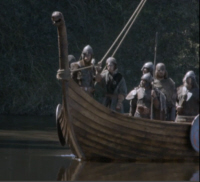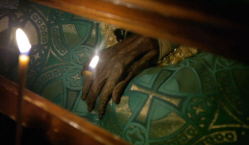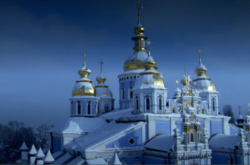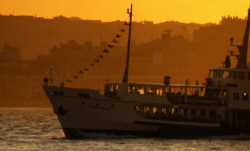Viking Conquest Into The Light
After the fall of Rome in the fifth century A.D., Europe huddled, her optimism froze. Strange migrants poured in from the east. Towns shrunk. Learning was forgotten. The vitality came not from the old centres but from the edges. And no people were more vital, more unexpected than the Vikings.
Crossing the seas and oceans by flat-bottomed boat, the Vikings had already terrorised and begun to colonise the British Isles, Iceland and France. They’d even reached Greenland and North America. Now they were heading deep into the heartlands of Eastern Europe.

When it comes to civilisation, the Vikings from Norway, Sweden and Denmark haven’t had a very good press. Europeans tended to see them as a ravening marauders, pagans without mercy. They prayed to God, “Preserve us from the fury of the Norsemen.”
And raid they did, quite a bit of ravening. But the reason the Vikings really matter is because their greatest talent was for settling down.
And one morning in year 882, a group of Slavs in the small trading settlement of Kiev were about to be confronted by this strange talent of the men from the North.

We know what happened next, astonishingly enough, through written records. Though only from the point of view of the Vikings, or the Rus’, as they were known. Below the ancient monastery of the caves in the Ukrainian capital of Kiev is a labyrinth of cells and underground churches - the last resting place of mummified monks. And here, in the early 10th century, some of the monks wrote what became known as the Russian Primary Chronicle.
The great thing about the Primary Chronicle is that it is the Vikings speaking. It’s quite clearly the Viking world view still. And the story it tells is that local Slav tribes had no law and rose up against one another. And so they went to the Rus’ and they said, “Our land is vast and rich, but it has no order in it. Come in and rule over us.”

Is it likely that the invitation was quite so polite? No. But come the Vikings did!
At the head of their expedition was Oleg, a Viking prince and leader of the Rus’. He now staked his claim to Kiev.
Victorious, Oleg declared himself the new Prince of Kiev. And Kiev grew into the royal capital of the region that became known as the land of the Rus’.
Or as we’d say it today… Russia.
Kiev still celebrates Oleg’s victory as its real founding moment. And quite rightly because what Oleg achieved was he united all the tribes around and forced them to pay tribute. He and the Vikings now had a stranglehold on all the trade running from north to south.

Many great civilisations have begun on riverbanks. And here on the Dnieper, furs, wax and slaves went south, while silver - mined in Afghanistan by the powerful, new civilisations of Islam - went north. At the mouth of the Dnieper was the Black Sea - Gateway to the largest and wealthiest city in Europe, Miklagard, the Viking name for Constantinople.
A source of trade and ideas, it was also home to the Greek Orthodox Christian church.
A century after its birth, Kiev was still as pagan as it’s Viking founders. Its ruler at the time, Vladimir the Great, wasn’t an obviously religious man. One chronicler described him as “Fornicator immensus”. But Vladimir decided that an up-and-coming city needed one of these fashionable, new-fangled religions. And he came up with his own unusual way of choosing which one.
It’s said that he asked representatives of Roman Catholicism, Greek Orthodox Christianity, Judaism and Islam to come here and persuade him. “Go on, argue. Convert me.”. The old Viking warrior was quite interested in Islam until he heard that it would involve giving up alcohol, at which point he said, in effect, “OK, you’re out”. In the end, he chose Greek Orthodox Christianity and began to build the first stone church in Kiev. It was a momentous choice because so much of what we think of as the look of old Russia, those onion domes, the priests and the monasteries and the icons, all goes back to Vladimir’s decision.
What had started with trade - furs and silver - had flowered into culture, architecture and religion. By the 10th century, Europe had an eastern Christian border, drawn by the Vikings and lasting to the present day.
